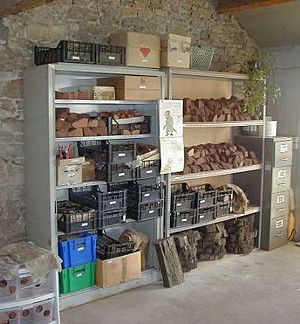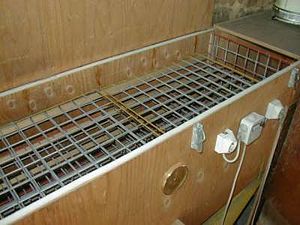Curing & Treating
From Creating, Briar, by Trever Talbert, from his website, and used by permission.
Curing & Treating
The first and most important step in the curing process is proper aging. I don't believe that any process, no matter how sophisticated, can bypass the need to age the wood and let it dry naturally. My long-term stock is kept stored in a dark drying shed for at least a couple of years before I even touch it (the vast majority of my briar stock has been air-drying for over 15 years), and then it transfers to my workshop where it sits in ventilated storage shelves being regularly turned for another year before being used. Ideally, I believe at least 5 years of natural aging is essential to the wood.
Here you see the briar in my workshop, all of which is ready for use now. I keep it on these shelves and turn the pieces regularly to give them plenty of ventilation as well as the temperature variances of the seasons.
In addition to the original aging of the wood, each stummel gets a few extra steps before becoming a finished pipe. I let the drilled and shaped stummels sit in natural sunlight for a period of several weeks before finishing them, since even in old briar, there is often latent moisture in the heart of the block. Once the wood is opened, it will dry and change further, and this grace period allows it to fully mature. Once the natural drying is done, I take the process a few extra steps with controlled heating and some dehydration techniques.
Pictured here is our wood dryer, which we have begun to work with since moving to France. Air is ventilated, heated, and filtered 24 hours a day across the wood on the wire racks.
First, the stummels are boiled one last time in a mixture I learned from Mike Butera, which has the effect of removing any remaining resin from with the drilled tobacco chamber and also of enhancing the wood's burn resistance. After this, the stummels are dried naturally and treated with yet another process to aid the removal of the water gained during boiling. We've begun to work with the wood dryer we acquired with the new shop but have not yet incorporated it into our production in a steady fashion. I do not believe that artificially-dried briar is in any way equal to naturally-dried briar so this will never be used for "speed drying" of our stock. It may, however, be used to enhance the wood in later stages of use if possible.
The last step in the preparation of the wood is to apply a thin layer of carbon to the bowl interior. I use a proprietary mixture that I've developed over the last several years of fiddling around with alternatives to the usual silicate or milk-paste mixes. The charcoal allows moisture from the tobacco to pass through normally into the wood, maintaining the ongoing symbiosis between briar and smoking, while the binding agent I use helps cake adhere quickly to the walls during the break-in smokes. Briar curing and seasoning is a process I'm still experimenting with very actively, and I'm sure this part of the process will change and improve over time, though I'm pleased with the results currently.

